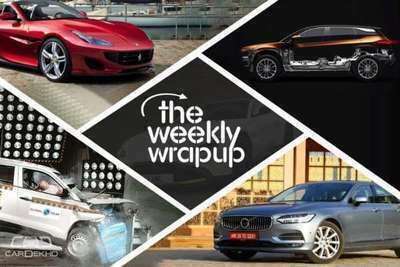Nutson's Weekly Auto News Wrap-up June 2-8, 2024
 |
 |
LEARN MORE: Complete versions of today's news nuggets, along with thousands of pages of relevant news and opinions, information stored in a million-page library published and indexed on The Auto Channel during the past 25 years. Complete information can be found by copying a headline and inserting it into any Site Search Box.
Here are Larry's top story picks from this past week's important to you, relevant, semi-secret, or snappy automotive news, opinions and insider back stories presented as expertly crafted easy-to-understand automotive news nuggets.
Nutson's Auto News Weekly Wrap-up June 2-8, 2024.
* May auto sales. US May auto sales ticked higher from the previous month and are up year over year on a seasonally adjusted annual rate (SAAR), but demand continues to face headwinds from widespread staff reductions and companies scaling back procurement. Ford, Toyota, Honda, Hyundai, Kia posted robust U.S. sales gains in May. The SAAR is around 16 million, varying slightly in different reports. EV sales are approaching 9% of the total market, with a strong presence in coastal regions.
* New fuel mileage standards. The Biden administration tightened vehicle fuel mileage standards, part of its strategy to transform the American auto market into one that is dominated by electric vehicles that do not emit the pollution that is heating the planet. The new mileage standards announced by the Transportation Department are among several regulations the administration is using to prod carmakers to produce more electric vehicles. The new standards require American automakers to increase fuel economy so that, across their product lines, their passenger cars would average 65 miles per gallon by 2031, up from 48.7 miles today. The average mileage for light trucks, including pickup trucks and sport utility vehicles, would have to reach 45 miles per gallon, up from 35.1 miles per gallon. Automakers said that they were generally satisfied with the new mileage rule.
* Large SUVs not so safe. For drivers of large SUVs, their imposing size comes with a sense of security. But some models are safer than others, new ratings from the Insurance Institute for Highway Safety show. The Jeep Wagoneer is the only model out of three popular large SUVs tested to qualify for a 2024 TOP SAFETY PICK award. Other bestsellers, the Chevrolet Tahoe and Ford Expedition, fell short for multiple reasons, including subpar performance in the small overlap front crash test. More than 90% of new models have sailed through this evaluation with good ratings since 2021. These vehicles are designed to be people haulers, as well as to tow boats and campers. But none of them offers good protection for back seat passengers (where children are seated) — a shortcoming that prevents the Wagoneer from earning the higher-tier TOP SAFETY PICK+ award. HERE
* More hybrids from Ford. The Detroit News reports Ford Motor Co. CEO Jim Farley said that "partial electrification" options like hybrids and extended-range electric vehicles are more than just "transitional" technologies. The auto industry over the past year has reevaluated all-electric vehicle adoption timelines, given affordability and range challenges. Ford and others have reemphasized hybrid technologies or said they are reintroducing them in the coming years. Partial electrification, Farley said, is increasingly part of that solution, noting that the hybrid F-150 truck represents a quarter of sales. Beyond hybrids and plug-in hybrids, the category includes extended-range electric vehicles, or EREVs. Typically, they're vehicles that run fully off batteries, but have a generator, usually a combustion engine, onboard that recharges the battery, extending its range. Full story HERE
* More plug-in vehicles.In 2023, California had the highest share of light-duty plug-in electric vehicle (PEV) registrations (i.e., number of vehicles on the road) representing 4.3% of all light-duty vehicle registrations in the state. The next highest was the District of Columbia (DC) with 3.5% followed by Hawaii at 2.8%. There were nine states (plus DC) with PEV registrations of 2% or more and half of the states had PEV registrations of at least 1%. As the United States moves towards decarbonization, it is noteworthy that plug-in vehicles are an increasingly measurable portion of the overall light-duty vehicle population. Note: Includes both all-electric (BEV) and plug-in hybrid (PHEV) registrations.
* EVs? Maybe! About 4 in 10 U.S. adults say they would be at least somewhat likely to buy an EV the next time they buy a car, according to the poll by The Associated Press-NORC Center for Public Affairs Research and the Energy Policy Institute at the University of Chicago, while 46% say they are not too likely or not at all likely to purchase one. Younger people are more open to eventually purchasing an EV than older adults. More than half of those under 45 say they are at least “somewhat” likely to consider an EV purchase. About 32% of those over 45 are somewhat likely to buy an EV, the poll shows. Full story HERE
* Oil prices. From the Wall Street Journal we read, OPEC+ tentatively agreed to extend all production curbs into next year, a deal that gives the cartel considerable leeway to make adjustments depending on market conditions and that likely signals oil prices will remain elevated through the US presidential election. The group has long-standing official reductions of 3.66 million barrels a day. While gas prices have drifted downwards, the extension of the cuts are likely to keep them from falling dramatically.
* Car thefts.Social media is driving car theft trends for the second year in a row, according to a new National Insurance Crime Bureau (NICB) report.[1] In 2021, Kia and its parent company, Hyundai, didn’t manufacture any of America’s 10 most stolen vehicles. The following year, after a viral Kia Challenge took off on TikTok, one Kia and two Hyundai models were among the top 10 in 2022 — a trend that accelerated in 2023. Washington, D.C., has the highest car theft rate in the nation, with 1,150 thefts per 100,000 people, according to the NICB. Residents also pay the sixth-highest car insurance rates in the country. Aside from the vulnerable Kia and Hyundai cars, the vehicles with the most thefts — like the Honda Accord, Honda Civic, and Ford F-150 — are among the most common models on U.S. roads. Details : HERE
* Pause on congestion pricing. Weeks before New York was to charge motorists to enter Manhattan’s business district, Gov. Kathy Hochul postponed the congestion pricing program, citing economic concerns. The move angered environmentalists, transit advocates and economists, with some accusing the governor of abandoning a plan that was decades in the making for political reasons in a critical election year. The congestion pricing plan, the first of its kind in the nation, was slated to start June 30. Drivers using E-ZPass would have paid as much as $15 to enter Manhattan south of 60th Street. HERE
* Honda recall. Honda is recalling more than 114,000 of its previously recalled Fit hatchbacks and HR-V SUVs for a defective rearview camera that may not display an image. Affected vehicles include model-year 2018-20 Honda Fits and 2019-22 Honda HR-Vs. A design flaw in the audio display power circuit may result in the rearview camera image not displaying when the engine is started with a key. This can reduce driver visibility and increase the risk of a crash.
* Toyota recall. Toyota Motor is recalling roughly 102,000 vehicles over concerns that stray debris in the engine can lead to a stall and loss of drive power. Included in the recall are about 3,500 Lexus LX 600 SUVs from model years 2022 and 2023, and 98,600 Toyota Tundra pickups from the same model years, according to the National Highway Traffic Safety Administration. The agency warned that those vehicles’ V35A engines produced during that time period at certain factories may not have had machining debris cleared during assembly.
* Obnoxious car exhaust noise. Miles Hudson is known for speeding and loudly revving his modified, tiger-striped Dodge Charger Hellcat SRT through Seattle, angering some residents and racking up various traffic and city citations for excessive noise. Seattle has now ordered the ‘Belltown Hellcat’ Instagram influencer to pay city fines amounting to $83,620. Be further entertained HERE
* Greenwich Concours. A 1931 Cadillac 452A was chosen as this year’s Best of Show at the 28th annual Greenwich Concours d’Elegance and the Barris-Built 1957 Chevrolet 210 ‘El Capitola’ was chosen as Best of Show at Saturday’s Concours de Sport. The Best of Show Concours d’Elegance winning 1931 Cadillac 452A iss owned by Leigh Brent. This car was formerly part of the renowned Charles Gillet Collection and is among the final cars built by Fleetwood in Pennsylvania. It is 1-of-4 All-Weather Phaetons known to survive. The Best of Show Concours de Sport winning 1957 Chevrolet 210 is owned by Tim McMann. El Capitola was commissioned by Don Fletcher in 1957 with design and execution by Sam Barris in 1957-58 and the interior, paint and glass by Barris Kustom City in 1958.
* RIP. Parnelli Jones, the 1963 Indianapolis 500 winner and the first driver to qualify for the “500” faster than 150 mph, passed away peacefully with his family by his side June 4 in Torrance, California. He was 90. One of the most versatile drivers in history, Jones was highly rated by all his competitors, including several of the best from Europe. He competed in the Indianapolis 500 seven times. Full story : HERE
Stay safe. Be Well.


